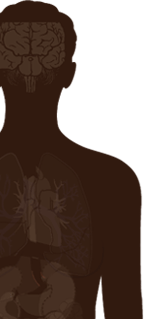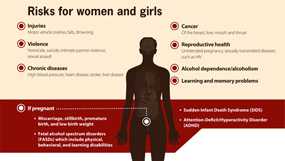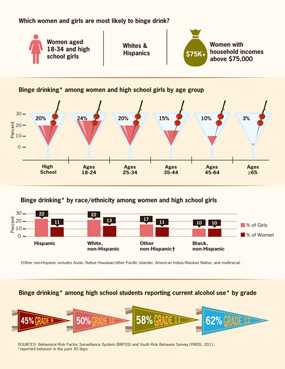Binge Drinking
A Serious, Under-Recognized Problem Among Women and Girls

 1 in 8
1 in 8
Nearly 14 million US women binge drink about 3 times a month.
 6
6
Women average 6 drinks per binge.
 1 in 5
1 in 5
1 in 5 high school girls binge drink.
Binge drinking is a dangerous behavior but is not widely recognized as a women’s health problem. Drinking too much – including binge drinking* – results in about 23,000 deaths in women and girls each year. Binge drinking increases the chances of breast cancer, heart disease, sexually transmitted diseases, unintended pregnancy, and many other health problems. Drinking during pregnancy can lead to sudden infant death syndrome and fetal alcohol spectrum disorders.
About 1 in 8 women aged 18 years and older and 1 in 5 high school girls binge drink. Women who binge drink do so frequently – about 3 times a month – and have about 6 drinks per binge. There are effective actions communities can take to prevent binge drinking among women and girls.
*Binge drinking for women is defined as consuming 4 ormore alcohol drinks (beer, wine, or liquor) on an occasion.
Problem
Drinking too much can seriously affect the health of women and girls.
Drinking too much can seriously affect the health of women and girls.
- Women’s and girls’ bodies respond to alcohol differently than men’s. It takes less alcohol for women to get intoxicated because of their size and how they process alcohol.
- Binge drinking can lead to unintended pregnancies. It is not safe to drink at any time during pregnancy.
- If women binge drink while pregnant, they risk exposing their developing baby to high levels of alcohol, increasing the chances the baby will be harmed by the mother’s alcohol use.
Drinking is influenced by your community and your relationships.
- Alcohol use in a community is affected by alcohol’s price and availability.
- Underage drinking is affected by exposure to alcohol marketing.
- Underage drinking is also influenced by adult drinking, and youth often obtain alcohol from adults.
Who's At Risk
What Can Be Done
Federal agencies and national partners are
- Recognizing that binge drinking is an important women’s health issue.
- Working with states and communities to support Community Guide recommendations to reduce binge drinking.
- Informing people about the US Dietary Guidelines on alcohol consumption (see box).
- Helping states and communities to report on how many people binge drink, how often and how much they drink when they binge, and whether health care providers are screening and counseling for excessive alcohol use.
- Reporting on youth exposure to alcohol marketing because it influences underage drinking.
We know what works
The Guide to Community Preventive Services (Community Guide) recommends effective policies to prevent binge drinking.
States and communities can
- Follow Community Guide recommendations to reduce binge drinking. The same approaches that work in the population as a whole can work for women and girls.
- Increase enforcement of laws on the sale and consumption of alcohol.
- Develop partnerships with a variety of groups, including schools, women’s and girls’ organizations, law enforcement, and public health agencies to reduce binge drinking.
- Report on how many people binge drink, how often, and how much they drink when they binge.
Doctors, nurses, and others who treat patients can
- Ask women about binge drinking and counsel those who do to drink less (see Screening and Behavioral Counseling Interventions in Primary Care to Reduce Alcohol Misuse). This screening and counseling can also be effectively done using the internet, telephone, or other electronic methods, as recommended by the Community Guide.
- Advise women who are pregnant or might be pregnant not to drink at all.
- Recognize that most binge drinkers are not alcohol dependent or alcoholics, but may need counseling.
- Support effective policies to prevent binge drinking such as those recommended by the Community Guide.
Women and girls can
- Avoid binge drinking. If you choose to drink alcohol, follow the US Dietary Guidelines.
- Choose not to drink alcohol if you are underage or if there is any chance you could be pregnant.
- Be cautious about consuming drinks if the alcohol content is unknown to you.
Key Points on Alcohol Consumption from the 2010 US Dietary Guidelines for Americans
- Don’t begin drinking or drink more frequently on the basis of potential health benefits.
- If you do choose to drink, do so in moderation. This is defined as up to 1 drink a day for women or 2 for men.
- Don’t drink at all if you are under age 21, pregnant or may be pregnant, or have health problems that could be made worse by drinking.
Science Behind the Issue
Related Pages
- Vital Signs Issue details: Binge Drinking Among Women and High School Girls — United States, 2011 Morbidity and Mortality Weekly Report (MMWR)
- CDC Feature- Binge Drinking Among Women and Girls
- Vital Signs – Binge Drinking Among Women and Girls [PODCAST – 1:15 minutes]
- Vital Signs – Binge Drinking Among Women and Girls [PSA – 0:60 seconds]
On Other Web Sites
- Page last reviewed: January 8, 2013
- Page last updated: October 11, 2013
- Content source:
- National Center for Chronic Disease Prevention and Health Promotion, Division of Population Health, Alcohol and Public Health, Division of Reproductive Health, National Center on Birth Defects and Developmental Disabilities, Fetal Alcohol Spectrum Disorders, Office of Women’s Health
- Page maintained by: Office of the Associate Director for Communications (OADC)


 ShareCompartir
ShareCompartir


